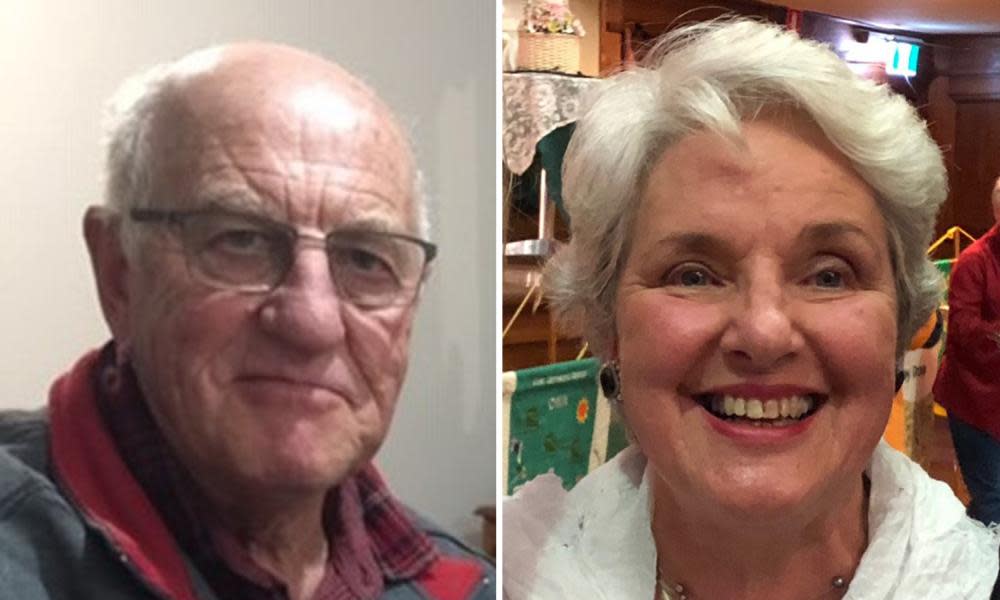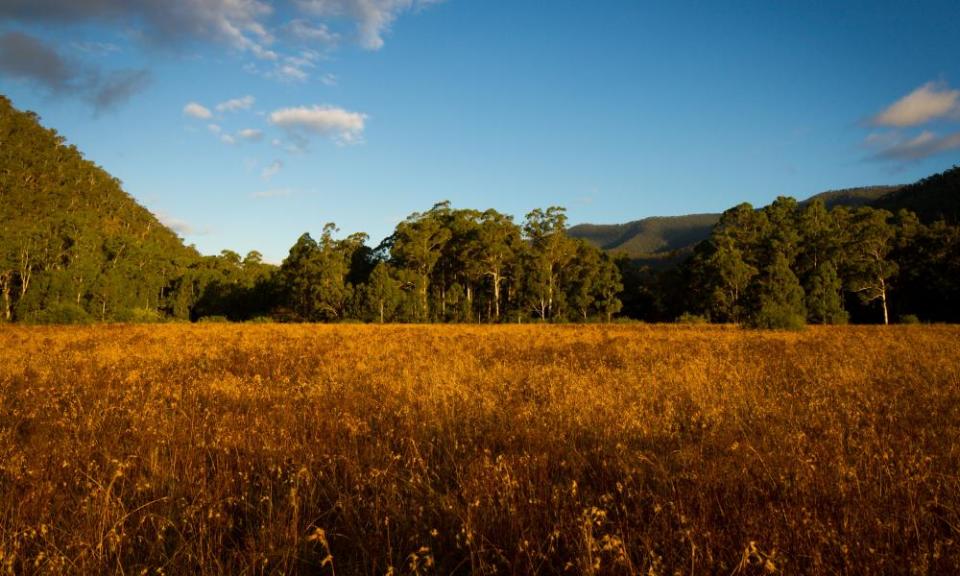Victorian Alps disappearance: the friends who went into Australia's wilderness and never came back

A year ago, two friends in their 70s went missing in some of the wildest terrain in Australia: Wonnangatta Valley. It’s the sort of place where you might go days without seeing anyone, with only kangaroos and snakes for company. A place of snow-capped mountains – even in summer. A place of bushfires and danger.
The sort of place where it’s easy to get lost.
Russell Hill and Carol Clay are thought to be dead. But technically they’re still just missing.
People go missing all the time. But the Australian psyche is haunted by disappearances in the vastness of its landscape. In its broad uninhabited expanses and in its peaks and valleys. The ethereal Picnic At Hanging Rock, where schoolgirls vanish off the face of the Earth. The terrifying Wolf Creek, where fun-seeking backpackers are tormented by a psychopath in Australia’s inescapable desert. And, of course, there are the entirely non-fictional stories.
UK backpacker Peter Falconio, murdered on an isolated Northern Territory highway, his partner Joanne Lees abducted.
The victims of serial killer Ivan Milat, backpackers hunted down in the Belanglo state forest. Stories of terror amid a terrible beauty.
Australia’s remote and wild places are seductive and spectacular, but their isolation can turn them into terrifying backdrops. Phones won’t work. GPS is useless. Even old-school maps don’t tell you where trails are blocked, where the steepness is insurmountable. A twisted ankle could doom you.
Of the 38,000 people who go missing in Australia every year, 98% are found. That still leaves a lot of people who never are.
Wonnangatta’s near where epic scenes from The Man From Snowy River were filmed, a place that is beautiful and fierce.
It’s a “national park that takes in a pristine river valley ringed by rugged snow-capped mountains” and is well-known, “thanks to its epic tracks and an enigmatic murder mystery”, according to the tourist guide.
More on that murder mystery later.
From what we know, Hill and Clay were adventurous people who planned a trip into the wilderness and never came back. But their story has captivating twists, none of which indicate a mundane twisted ankle.
Hill and Clay’s (separate) families knew they were (individually) going camping but didn’t know they were going together. Hill (74) was married, Clay (73) was divorced.
Here’s what we know:
Hill left his Drouin home on 19 March, and picked Clay up from her Pakenham home in his Toyota Landcruiser. Clay told friends she would be back in just over a week.
The next day, Hill made a call to a friend on his HF radio saying he was at Wonnangatta Valley. That was the last that was heard from the pair before campers found their campsite destroyed by fire. The Landcruiser had some minor fire damage. The analysis of the site was inconclusive.
Victoria police said this week it was “still yet to be fully determined whether the pair’s disappearance is suspicious”.
There’s plenty of flotsam and jetsam that has fed into this tale.
Hill took a drone with him. Then a drone was handed in to detectives. Police say it wasn’t connected, but they are still investigating it.
There are reports that Hill and Clay had been having a decades-long love affair.
There’s a report that police are closing in on suspects using information about a 4WD and phone records. There is even speculation about a shadowy figure called The Button Man, a recluse apparently living in the area. Police have spoken to the guy and cleared him, but apparently learned things. Things yet to be known.
Watch: Major development in the case of missing campers
And, this week, there were reports that police were looking at a possible sighting of the pair after they were last heard from, and appeals for information about a white dual cab ute seen near the campsite the day before they disappeared.
Police are bolstering their efforts to find out what happened. Cadaver dogs have been brought in.
What we don’t know: Were they murdered? Were they accidentally killed by deer hunters? Did they get lost? Was there an accident?
No one is wondering out loud if they’re still alive. The head of Victoria police’s missing persons squad, Detective Inspector Andrew Stamper, said this week that “it is highly unlikely that either Russell or Carol are still alive”.
Dr Sarah Wayland researches missing persons, what happens to them and what happens to their families. She says those left behind are in a hellish sort of limbo, stuck with the ambiguity of not knowing what happened.
The University of New England senior lecturer says when people go missing in remote areas, without bystanders, without eyewitness accounts, without CCTV, there’s a trauma in the not-knowing that can be quite different to how her United Kingdom colleagues think about missing persons.
It’s difficult to explain to her urban, urbane colleagues how different it is to deal with Australian cases in the total wilderness of the desert or the alps. Where the enormity and harshness of the landscape are dazzling.
In an essay published in The Lancet Psychiatry, she writes about Picnic At Hanging Rock, the book and film that depict schoolgirls and their teacher going missing in the Australian bush. The tale is imbued with mysticism and uncertainty.
“They might end up being gone forever but, while the person’s whereabouts are unknown, a continuing hope remains for their potential return, however miraculous,” she writes, pointing to the fantastical nature of the narrative.
She says families of missing persons she’s worked with are still stuck in the place of waiting, and not knowing, and says missing is “the ultimate complexity” as they rely on police investigations and coronial inquests and their own desperate searching.
Sometimes, decades later, the families are still stuck, wondering. Wayland says when people go missing in remote areas, in those historical cases, it’s important to keep reminding the community that they’re still missing.
If someone’s been bushwalking, four-wheel driving, and lost in the immensity of this island continent, there’s still a chance of solving the mystery if they’re not forgotten. Resolution can bring succour to their loved ones.
Detective Inspector Andrew StamperIt is highly unlikely that either Russell or Carol are still alive.
“Even if it’s a negative outcome,” Wayland says.
Journalist Anthony Sharwood spent about five weeks on the Australian Alps Walking Track, a rugged 660km “track” that is sometimes not even a track at all. The blurb for his recent book, From Snow to Ash, describes it as Australia’s toughest hiking trail. It’s a rugged, tough trek that traverses the High Country from Victoria to the Australian Capital Territory, via Wonnangatta.
“It’s definitely the sort of country where one ridge would look like the next,” Sharwood says. “One valley would look like the next. It’s wild, remote, it’s confusing country to the uninitiated.
“In my few days in that area I only saw two people. They were a pair of four-wheel drivers on a rough track on a slope so steep they had to winch their vehicle up it.
“This is not country you treat lightly. It’s country where the weather can change in minutes. It’s country where it can snow two or three times every summer.
“It’s a long, long way from help if anything happens.”
Sharwood says it’s green, lush, with towering snow gums and alpine ash trees – a “botanical paradise”.
It’s teeming with wildlife on its steep slopes.
A guide for visitors lists echidna and platypus as locals, along with the introduced sambar deer. It lures people despite the difficulty of getting there.
Victoria police urge anyone with information to contact CrimeStoppers. Stamper says the families’ grief, “coupled with immense public speculation”, is “immensely difficult to comprehend”.

“Our thoughts are with them on this anniversary,” he says. “I know they will be hanging on every phone call and every knock on the door, hoping they will finally get some answers. I want to reassure the community that we will not give up – we will meticulously follow up every single piece of information provided to us.
“We have increased the number of dedicated investigators looking into Russell and Carol’s disappearance and we remain strongly optimistic of giving these families the answers they need.”
Meanwhile, people do go missing all the time. But when it’s in those almost inaccessible parts of this vast landscape, where the wild country is an impassive enemy, it’s a different and more terrifying conundrum.
So. There is still that other unsolved Wonnangatta mystery.
In 1918, Wonnangatta Station manager James Barclay’s body was found near the homestead – a place that is now ruins, near the campsite that Hills and Clay made.
Anthony SharwoodIt’s wild, remote, it’s confusing country to the uninitiated.
Wild theories sprouted about what happened, one of them blaming Barclay’s cook, Jack Bamford. But then Bamford’s body turned up, and people thought maybe it was “bush justice”.
A third theory posits that cattle thieves in the area feared being exposed by Barclay and Bamford and murdered them both.
And a fourth is that Barclay had been having an illicit affair, and the woman’s husband killed him for it.
But way back in 2010, a volunteer with the East Gippsland Historical Society told the ABC that it was the very remoteness of Wonnangatta Station that made that unlikely.
Sharwood details the isolation of the alps. The odd characters who dwell there, the adventurous types who visit. How easy it is to get turned around, to find yourself in mortal peril. The need to plan for every eventuality, the surprise of being so utterly alone.
He hates a cliche. But it’s “in the middle of bloody nowhere”, he says. The middle of bloody nowhere, where some bodies, and some answers, will never be found.

 Yahoo News
Yahoo News 
